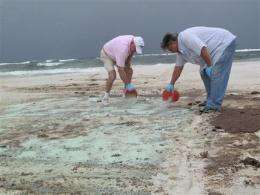Florida tests inventors' sand-cleaning ideas

(AP) -- Some inventors came with cotton fiber rolls, others with oil-clumping polymer mixes and one brought a specially designed rake. Their task: clean layers of crude oil and tar from a once-pristine Florida beach and prove they have the right stuff to combat the gummy onshore residue of the massive Gulf oil spill.
The 18 U.S. and Canadian inventors displayed their science to save Florida's beaches Thursday in a high-stakes clean-off under the critical gaze of evaluators. They were winnowed from among more than 400 people who submitted ideas.
"If we can find some gems out here, we hope we can start using them ASAP. We are looking for something that spreads easily and is effective. The answer isn't just one tool, we need a lot of tools for different weather conditions, for out in the water, on the beaches, in the marshes," said Darryl Boudreau, assistant director for the Northwest Florida district of the state Department of Environmental Protection.
Intermittent rains, winds and a driving surf churned by Hurricane Alex didn't stop dozens of local, state, Coast Guard and other officials from coming to watch. Evaluators from the state's environmental department, which organized the event, and from oil company BP PLC walked around the tar-covered beach to see the technologies in action and chat with inventors.
Kalty Vazquez of Miami held a bucket in one hand and with the other he spread a green-sandy substance called GreenTech over his plot. Vazquez then raked through the tar and GreenTech and scooped the raked sand with a strainer, leaving mostly clean sand behind. He later demonstrated how GreenTech worked in water, helping to form larger tar balls that are easier to pick up.
Watching closely, clipboard in hand and dressed in full rain gear, evaluator Daniel Kuncicky had lots of complicated questions about how the polymer-based product worked.
Nearby, another group blanketed the sand with a cotton-fiber roll. The idea was for the oil and tar to adhere to the cotton when it was rolled up.
But the group said it worked best when heavy machinery rolled over the cotton and pressed it into the sand. Lacking the machinery, they stomped on the cotton with their feet. Only a small part of the mess was removed when the cotton came up.
Bill Vasden Jr. grows his oil spill cleanup solution on 1,500 acres in Tampa. The biodiesel and feed starch farmer believes kenaf, a kind of grass, is the answer to soaking up oil as it washes on shore. Vasden displayed kenaf booms on the beach.
Auto mechanics have long used the material to clean oil from their floors, he said.
"It's a fibrous grass, it's renewable and we can burn it for energy," he said. "We have 1,500 acres of it already."
Among those who came to check out the ideas was Buck Lee, chairman of the Santa Rosa Island Authority, which oversees Pensacola Beach.
"Whoever invents the magic dust is going to be a millionaire," Lee said, as he handled phone call after phone call from people concerned about the oil-covered beach.
Some solutions were simple.
Jeff Powell demonstrated a tar-ball rake. Powell's Pensacola-based company, Ellis Trap and Cage Manufacturing, has long sold crab and bait-fish traps and sand flea rakes. The oil spill has hit his company hard, so Powell said he came up with another idea - a rake that traps tar balls and filters out the sand. In about 30 minutes he raked his plot of sand and left a clean section.
Peat moss is Canadian John Green's answer. He demonstrated Sphagsorb, a microbe-enhanced peat moss. The product has worked in Canadian oil spills. Ten pounds of the Sphagsorb collects about 40 pounds of oil and tar, he said, as he spread the stuff over his plot. He glommed up a large wad of tar with his gloved hand to show how it caused the tar to stick together and made it easier to remove.
Other ideas included spraying microbes onto the sand with containers that looked like bug sprayers, and mesh matting that could be removed from the sand after the tar washes on shore.
After an hour, the small section of beach in front of the public walkway where the inventors demonstrated their ideas looked much cleaner than when they started.
But evaluators were mum about whether they would choose any of the ideas or how quickly the public might see them in action.
©2010 The Associated Press. All rights reserved. This material may not be published, broadcast, rewritten or redistributed.

















